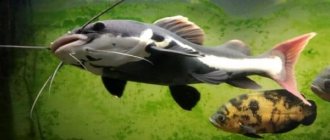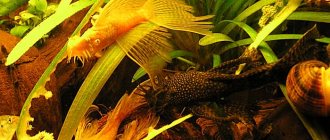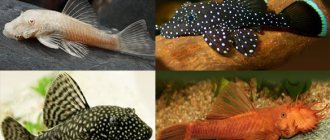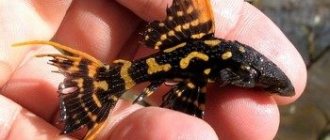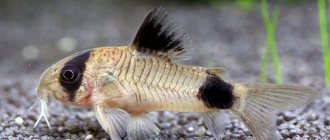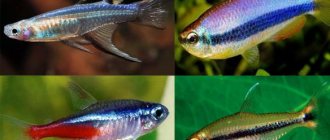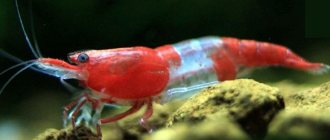Maintenance and care, arrangement of the aquarium
The optimal size of an aquarium for one adult fish starts from 200 liters. The design is recommended to recreate conditions reminiscent of the natural habitat - a river bottom with a slow flow of water with a sandy substrate and an intricate labyrinth of tree roots and branches. Lighting should be dim. If you plan to use living plants, you will need to select shade-loving species that can attach to the surface of driftwood. Any vegetation that takes root in the ground will soon be dug up. A layer of leaves from some trees will complete the design. They will not only become part of the decor, but will also allow you to give the water a chemical composition similar to that in which Ancistrus vulgaris lives in nature. As the leaves decompose, they will begin to release tannins, particularly tannins, which turn the water brown and help lower pH and dGH values. Read more in a separate article “Which tree leaves can be used in an aquarium.” Like most other fish that come from undisturbed natural habitats, they are intolerant of the accumulation of organic waste and require impeccable water quality. For this purpose, regular aquarium maintenance procedures are carried out and a productive filtration system and other equipment are installed.
Habitat
Ancistrus common (Ancistrus Dolichopterus) distribution places
The homeland of Ancistrus is the Amazon River in South America. It prefers fast-flowing waters of rivers and mountain streams, but can also be found in forest lakes and swamps.
Ancistrus Dolichopterus habitats.
Care and maintenance
The catfish stuck almost all day long searching for and eating new food. Thus, it fights algae and food debris in the aquarium. He does this with the help of his suction cup. Inside the aquarium, they rarely reach a size larger than 15 cm. Despite their usefulness, they do not look so attractive to many: a suction cup mouth, dark color, mustaches near the mouth.
Ancistrus catfish (Latin name ancistrus dolichopterus) likes to hang upside down or hide under all sorts of objects, so it is very good to add ceramic pots, large driftwood, and coconuts to your aquarium. By the way, adding driftwood to an aquarium can not only provide shelter, but also be beneficial for their digestion. The fact is that wood contains lignin, by scraping which fish improve their digestion. The cleaner catfish actively eats leftover food, but at the same time actively excretes waste products, so it is advisable to install a good filter in the aquarium.
As stated above, catfish are rightfully considered one of the most resistant species; Ancistrus requires minimal maintenance and care, and you really need to try hard to ensure that the aquarium conditions do not suit it. But let’s give an approximate characteristic that will be most favorable for him:
- Water parameters: pH 6–7.3 dH up to 10°, KH up to 2°, water hardness no more than 20–25 dH;
- Water temperature: 20–26 °C (ideal 22 °C).
They love clean water with a lot of oxygen, so don’t forget to change it periodically and also provide aeration. An interesting observation is that sucker catfish are larger in size, as a rule, the lower the water temperature.
What to feed Ancistrus
Sticky fish love to eat, but in addition to leftover food, they will gladly eat:
- plant foods based on spirulina (can be found in tablets, they dissolve well in water and attract with their smell);
- frozen food (bloodworm or coretra);
- vegetables (scalded pieces of zucchini, cucumbers, spinach, peas, pumpkin or lettuce, cabbage);
- tubifex worms, insect larvae, daphnia, cyclops or other worms.
To avoid contaminating the water, be sure to remove any uneaten remains. In general, catfish adhere to lovers of plant food, but when there is a lack of nutrition, they switch to a live diet. 70–80% plant foods and 20–30% protein are recommended. Follow the rule that food should not be monotonous; food should be both live and dry.
Due to the fact that sucker fish are quite active, they require quite a lot of space, so the aquarium should be spacious. For a couple (male and female), the recommended aquarium volume is 80 liters or more. Of course, they can be kept in smaller volumes, but most often the fish in a smaller volume dies. With proper care, aquarium cleaners live quite a long time. Ancistrus live 6–8 years, although sometimes they live longer, for example, up to 12.
Ancistrus catfish - description and characteristics
The body of the Ancistrus catfish is flat and flattened, covered with polygonal bony plates. The body of the blue ancistra catfish has a pair of pectoral and ventral fins. These fish are very notable for their elongated lips, which have horn-like suckers and a rounded lower mouth. Thanks to their suckers, fish are adapted to life in fast-flowing waters, as they stick to snags and stones. These suckers have horny tubercles that scrape off all kinds of animal and plant fouling from surfaces, which is their natural nutrition. The aquarium catfish Ancistrus uses a suction cup to clean glass and stones inside the aquarium.
Adult Ancistrus catfish have a dark brown or grayish color with light dots that are randomly scattered throughout the body. On the fins these points merge into strokes. The back is darker than the ventral side. Dark spots are found on the caudal and dorsal fins of catfish, while olive and grayish-blue spots are found on the ventral and pectoral fins.
The maximum length of the aquarium catfish Ancistrus reaches 15 centimeters. The lifespan of the fish is 6-8 years, but usually ancistrus live shorter, as they die earlier.
Ancistrus and its compatibility with other fish
If we talk about how the ancistrus will get along with other fish, then dry statistics come into play - it will get along perfectly. Is it with all the fish? Unfortunately, no, and let's look at why.
Ancistrus can be dangerous for large, slow-moving fish that lack scales. Crawling over a large object, without any malicious intent, catfish can damage the skin of fish.
But not only danger can come from ancistrus. Large cichlids are dangerous enemies of our cute catfish. There is a suspicion that cichlids that build nests on the bottom regard ancistrus as a potential threat to encroach on their nests, and this is already a reason to attack. Try to avoid the proximity of large aggressive cichlids to Ancistrus. Even their chain mail armor may not save the latter.
Compatibility
Since catfish adapt well to any conditions, are nocturnal and crawl along the bottom, they are excellent neighbors for most aquarium inhabitants. Herbivores and small-sized ancistrus can be perceived by some large predatory fish as prey, so you should not house them together.
Adult catfish are covered in armor, making them impossible for predators of the same size to eat. Adult cichlids and ancistrus are dangerous, as they can eat not only juveniles, but also adults. When creating a species aquarium, you should take into account the number of individuals per unit area of the bottom of the aquarium.
Diseases of catfish
When buying fish, many people do not even suspect that their pets can get sick. Identifying the disease in catfish can be problematic, because the fish are nocturnal and rarely swim out for public viewing in daylight. Ancistrus may experience a number of health problems:
- White spots on the fish's body may appear due to stress. In this case, we are not talking about illness, but about stress staining. In a stressful situation, ancistrus become dull and partially lose pigmentation. This can happen when transplanting a catfish from a familiar container to another aquarium, as well as after transportation. The infectious disease in the form of white spots can be carried by other fish. Therefore, after acquiring new neighbors for the catfish, they must be kept in a quarantine tank for at least 2 weeks. If the color of the catfish has changed and spots have appeared, it is also isolated. Quarantine and treatment last for at least 14 days. For treatment, purchase the drug Antipar.
- Ichthyophthiriasis resembles a scattering of semolina on the body of a fish. The disease is caused by the ciliate ichthyophthirius. For treatment, potassium permanganate, copper sulfate, malachite greens and formaldehyde are used. These substances can lead to the death of algae and invertebrates inhabiting the aquarium.
- Velvet disease or oodiniosis may not manifest itself for a long time, but under unfavorable conditions (stress, changes in water parameters) it will begin to progress. Sick individuals are characterized by reduced activity. Their fins turn into fragments of sharp rays, on which there is no interray tissue. The fish's skin will begin to peel off, and the body will resemble velvet fabric. Without treatment with antibiotics, the disease cannot be controlled. For 100 liters of water you will need 1 bottle of Bicillin-5. On the second day, perform a partial water change (30%) and repeat the administration of the drug. After 48 hours, the treatment is repeated, a control administration of the drug is carried out a week later. The treatment is considered effective, but the algae die.
- With chilodonellosis, cloudy areas of a bluish tint appear on the sides and back of the fish. It is necessary to examine the caudal fin if it is tightly compressed but not disheveled - this is a sure sign of disease. Levomycetin is used for treatment. For 100 liters of water, 3 g of the drug is needed. The product is added 3 times, maintaining 48-hour intervals. Before adding the dissolved drug, the water in the aquarium is replaced by 1/3. Additionally, you can raise the temperature in the aquarium to +28-30°C and add 3 tbsp to the water. salt. But such an additive will contribute to the death of algae.
- Dropsy is hard to miss. The catfish's belly swells and it stops defecating. For treatment, it is necessary to remove the sick individual and add Levomycetin (75 ml/l) or Ciprofloxacin (50 ml/l) to the water. The water temperature must be at least +27°C. Treatment is carried out for several days in a row. Effectiveness is indicated by a shrinking belly and the appearance of bowel movements.
From the editor: Asphyxia of fish
Ancistrus starata is a good choice for a freshwater aquarium. The peaceful existence of the catfish with other fish will allow it to rationally fill all layers of the home pond.
Difficulty in content
Ancistrus is one of the most unpretentious aquarium fish to keep, which attracts even inexperienced hobbyists. Thanks to their ability to easily adapt to any proposed conditions, sticky catfish coexist with any fish. The only difficulty is the sensitivity of the “youth” to the pH of the water.
However, catfish love a clean, oxygen-rich environment. For their comfort, the home pond must be equipped with a good, powerful aeration and filtration system. Since these gluttons leave a large amount of waste, it is necessary to clean up the soil.
It should also be taken into account that the peaceful nature of catfish crawling phlegmatically along the bottom changes if there are not enough females in the school or there is little food. Males can cause real carnage.
Diseases
Ancistrus catfish are not in poor health, but some diseases also affect them. A common cause of disease is failure to maintain cleanliness and hygiene of the aquarium, untimely change of water, and rotting of food particles stuck between stones. Therefore, the best prevention of diseases in the aquarium inhabitants is timely cleaning and replacement of water.
In order to promptly determine the deteriorating health of ancistrus, you need to monitor the condition of your pets every day. If you recognize the disease in advance, it can be easily cured.
Symptoms of a sick catfish:
- Unusual behavior, uncharacteristic actions. Sluggish and inhibited or overly active behavior in combination with other symptoms indicates some kind of disturbance in the body.
- Change in fish color. More often the yellow color fades and loses its brightness. But this also happens after the spawning process, so this symptom is inaccurate.
- Poor appetite or its complete absence. Healthy fish are always ready to feed and swim to the place of food. And the patient remains in the shelter and does not touch the food.
- The formation of unhealthy plaque on the skin and scales.
Fish with one or more symptoms are separated from the others. Most often, catfish are affected by fin rot, swim bladder disorder and bacterial diseases.
Popularity history
Indeed, today it is rare to find an aquarium where there are no catfish peeking around the corner at their owners in anticipation of food, or climbing on the glass, scratching it. Where does the popularity come from? Why the Ancistrus catfish? It’s worth starting with the fact that this common ancistrus is an incredibly unpretentious fish. Of course, she, like all other inhabitants of freshwater aquariums, has her own comfortable maintenance criteria and desirable water characteristics.
But the surprising fact is that Ancistrus can adapt to living conditions that do not fit within acceptable limits. If the temperature conditions for keeping freshwater aquarium fish vary from 21 to 26 degrees on average, then these catfish can feel comfortable both in water 5 degrees warmer than normal and 5 degrees colder. Of course, it’s not worth bringing it to this point, but if suddenly something goes wrong and the peak water temperature reaches a critical level, there’s no need to worry about anyone but the ancistrus. These catfish are herbivores.
They feed on algae deposits on glass, rocks and decorations in the aquarium. They are also fed with special granular tablets, which contain the plant component of the diet. But these catfish will also eat food that was not eaten by other fish. This is the main benefit of these fish. Once decomposed, the food will begin to saturate the water with substances useful for plant growth. But if you don’t have enough of them in your aquarium, or none at all, then algae will begin to use this luxurious food, and soon you will see a tendency to pollute the aquarium. Green five-centimeter threads of algae will definitely not add charm to your aquarium.
Features of Ancistrus catfish
This catfish is a unique fish because it differs from others in its unusual appearance and way of life. It has a suction cup mouth that sticks to aquarium walls, rocks, decorations and even plants. This mouth has horn-shaped scrapers that help clean objects around it, which is why it is called a cleaner.
Ancistrus does not swim, but moves in peculiar leaps. This catfish, unlike other fish, does not even have a swim bladder.
Under proper conditions in an aquarium, a catfish will live for about 7 years.
There are also visual differences between males and females. The male has tentacles (antennae) on his head. The female individual either does not have them, or the mustache is small and located on the sides. Ancistrus can also change sex. If a female lives alone for a long time, she can turn into a male.
If a female Ancistrus is alone for a long time, it can turn into a male.
As for coloring, the catfish has nothing to boast about. It has a dark gloomy color and is covered all over with white dots. Although, of course, like other species of fish, there are albinos, which have a bright yellow color.
So if a catfish is exploring the bottom, then at these moments it becomes an inconspicuous fish, which is even difficult to see.
The length of the stick reaches 10 cm, but if there is warm water in the aquarium, it will not reach them.
Characteristic
The first thing that catches your eye is its unusual color: a scattering of white specks on a black velvet belly. Such extravagant colors are associated with the starry sky, which is why Ancistrus got its name. The mouth is in the shape of a suction cup, with the help of which the fish feeds on plant deposits formed on stones and decorative elements. The tail and fins have a white stripe that fades with age.
The catfish grows up to 8 cm in length. The body is covered with durable plates and spines that protect the fish from the attacks of enemies. By nature, star ancistrus are peaceful, but clashes can occur among males. No attention is paid to aquarium fish of other species. They prefer a nocturnal lifestyle, and during the day they often hide in thickets. They are good at camouflage techniques and can freeze and remain in one position for hours.
Neighborhood among brothers
If we consider the intraspecific relationships of Ancistrus, then the concept that Ancistrus is a peaceful fish will be a little vague and not very correct. As one aquarist said - a peaceful fish under normal conditions!
What can be understood by normal conditions in the life of ancistrus? This, unfortunately, is not the conditions of detention, water parameters, length of daylight hours, or the regularity and variety of food.
Normal conditions in the life of these catfish can be called circumstances in which no one will need to prove or defend anything. What does it mean?
Normal conditions are when there is one pair of catfish in the aquarium, there is no need to take food from anyone, the male does not need to prove superiority over other males, when everyone has enough shelter and living space. Now let's look at these points in a little more detail.
Editorial: Pearl gourami
Living space
As you know, even guppies will be reluctant to live in a three-liter jar. It's the same story with catfish. If you keep ancistrus in a common aquarium, then for one pair you need about 60-70 liters for comfortable living.
If you plan to keep more individuals, then approximately the same volume will be needed for each pair. Why, and what can happen if you do not follow this instruction?
A similar situation can arise in a fairly spacious aquarium that does not have enough hiding places. Ancistrus will also fight for apartments, so if you plan to keep more than 2 individuals of these catfish, then try to provide them with grottoes, caves, amphorae, halves of coconut shells and, of course, driftwood.
Snags are a separate point in the life of ancistrus. In addition to the fact that this is a natural shelter for this catfish, it is also food. By scraping off a layer of wood, catfish saturate the body with useful substances that help maintain health at the proper level.
Guests
When all your inhabitants in the aquarium have already gotten acquainted and come to some common denominator, everything seems to have become quiet and peaceful, no one is chasing anyone or getting nervous. But a resonance can be caused by new ancistrus that you add to this aquarium.
As before, males and females will need to show who is boss and let newcomers know where their place is. If we are talking about a spacious aquarium with a lot of space and hiding places, then such conflicts usually end quite quickly.
Fathers and Sons
As you know, after the female lays eggs, she needs to be removed from the aquarium or the spawning ground must be equipped with many shelters. This is due to the fact that the bearded loving ancistrus, after completing the spawning process, becomes an aggressive defender of the future offspring. And his aggression is so great that in some cases the females died under the pressure of a fierce defender.
The father carefully waves his fins near the eggs, stimulating the flow of water to the future babies, removes unfertilized or dead eggs from the clutch, and this will continue until the larvae begin to swim. Only after a couple of days can dad calmly return to his business.
But if we consider a common aquarium in which a couple of ancistrus spawned, then after a while, or rather after 7-10 months, when the fry reaches sexual maturity, the sons will already be regarded as competing males, and there will no longer even be any family connection in mind. Then the rule “who is stronger is right” comes into play.
Popularity history
Indeed, today it is rare to find an aquarium where there are no catfish peeking around the corner at their owners in anticipation of food, or climbing on the glass, scratching it. Where does the popularity come from? Why the Ancistrus catfish?
It’s worth starting with the fact that this common ancistrus is an incredibly unpretentious fish. Of course, she, like all other inhabitants of freshwater aquariums, has her own comfortable maintenance criteria and desirable water characteristics. But the surprising fact is that Ancistrus can adapt to living conditions that do not fit within acceptable limits.
If the temperature conditions for keeping freshwater aquarium fish vary from 21 to 26 degrees on average, then these catfish can feel comfortable both in water 5 degrees warmer than normal and 5 degrees colder.
Of course, it’s not worth bringing it to this point, but if suddenly something goes wrong and the peak water temperature reaches a critical level, there’s no need to worry about anyone but the ancistrus.
These catfish are herbivores. They feed on algae deposits on glass, rocks and decorations in the aquarium. They are also fed with special granular tablets, which contain the plant component of the diet. But these catfish will also eat food that was not eaten by other fish.
This is the main benefit of these fish. Once decomposed, the food will begin to saturate the water with substances useful for plant growth. But if you don’t have enough of them in your aquarium, or none at all, then algae will begin to use this luxurious food, and soon you will see a tendency to pollute the aquarium. Green five-centimeter threads of algae will definitely not add charm to your aquarium.
Feeding Ancistrus
Ancistrus are typical herbivorous catfish, so the basis of their diet should be food with a high proportion of vegetation. Too large a percentage of animal food can lead to digestive disorders in Ancistrus. Therefore, under no circumstances should you feed them only live and frozen food (bloodworms, brine shrimp, tubifex). Such food, in addition, may pose a risk of introducing infections into the aquarium.
An excellent choice would be specialized dry food for chain catfish:
- Tetra Pleco Veggie Wafers are dense plates that quickly sink to the bottom and become accessible to ancistrus, which happily scrape off such food. Thanks to their special structure, they retain their shape for a long time and do not cause cloudiness in the water. The green area in the center of the tablets is a concentrate of algae and zucchini for excellent digestion of chain catfish.
- Tetra Pleco Spirulina Wafers is a tablet food for herbivorous fish with an algae concentrate, additionally enriched with Omega-3 acids, which support the fish’s immunity. The composition includes a large amount of plant fibers, which ensure comfortable digestion of ancistrus. The plates retain their shape for a long time and do not muddy the water.
- Tetra Pleco Tablets are a universal food for all types of bottom-feeding fish that feed on vegetation. It has the form of bulk tablets and quickly sinks to the bottom, where it gradually releases food particles. The tablets are enriched with spirulina, an algae that not only supports comfortable digestion, but also gives additional vitality.
Bottom tablets with algae will appeal to ancistrus
It is enough to feed ancistrus once a day. It is advisable to throw the food tablets after turning off the main lighting.
Sexual demorphism
Is this a boy or a girl? How to determine gender? The answer to this question can be given, but not immediately. As with most fish, there is no sex difference at an early age. It should be noted that there are more than 50 species of ancistrus, and not all of them are similar to each other.
If we consider Ancistrus classicus, then puberty occurs at the age of about 1 year. It is impossible to give a definite answer to this question due to several factors.
The development of a fish’s body can be influenced by:
- heredity. How strong were the producers;
- volume of the nursery aquarium;
- overcrowding of the growing area;
- nutrition;
- genetic strength of the young.
The maturation period of ancistrus can vary from 7 months to 14. And already at this age the first distinctive signs of gender differences will begin to appear.
At the first stage of maturation, some vegetation can be seen on the head of the catfish. These are the so-called tentacles. These are skin extensions that will later help you find out how males and females differ. In females they are located only on the edge of the head and are very few in number. They will grow no more than 1 millimeter and will no longer increase as the fish grows. In some species, females have no such vegetation at all.
The male Ancistrus will proudly wear a gorgeous beard. The male's tentacles are located all over the head, grow more than 1 centimeter in length, and will become branched as they mature. This distinctive feature is inherent in all types of Ancistrus.
But not in all species, as has been said, sex can be distinguished at this age. For example, if we consider Ancistrus stellata L181, a rarer and more beautiful color variation of the classic Ancistrus, then it is possible to distinguish the sex of these comrades only by 2 years of life. This causes some difficulties in breeding this species.
Breeding at home
You can determine the sex of ancistrus by its head and the presence of mustaches
How to distinguish a female from a male
Determining the sex of ancistrus is quite easy, but this can only be done after the fish have reached sexual maturity, which occurs in the second year of life. At this time, skin growths (whiskers) are formed in males on the upper jaw, reaching 2 centimeters in length, while in females they are absent. At the same time, the body of the female is larger, longer and slender, and their fins are longer and sharper than those of the males.
Reproduction of Ancistrus
The male ancistrus takes on the role of parent and cares for the eggs throughout the entire ripening period.
Ancistrus become sexually mature in the second year of development. After this, they can spawn up to five to six times a year. They can breed independently in a community aquarium.
If breeding is carried out purposefully, then the selected male and female need to be separated. For this you can use a small spawning aquarium (40 l). It must be equipped with driftwood, as well as shelters in which the eggs will be laid. A filtration and aeration system is also necessary. It is recommended to treat the water with methylene blue, which will help eliminate fungal flora.
From the editor: Neon diamond or diamond
You can identify a pregnant female by her “puffiness.” After this, preparation for spawning begins, and then the process itself:
The male very actively searches for the place where laying will take place, and then thoroughly cleans it. Over the course of a week, the female lays 30–100 small yellow, orange or pink eggs at night. The eggs are attached in clusters to the walls of the prepared shelter. At the end of the clutch, the male performs fertilization and drives the female out of the home. After this, it must be sent to a general aquarium. The male takes care of the offspring of Ancistrus.
He supplies oxygen to the clutch, fanning it with his fins, and removes non-viable eggs. During the ripening of eggs, you should not attract the attention of the male; if he panics, he can destroy the clutch. In good conditions, the larvae emerge within five days and feed on the gallbladder's reserves. When they run out, the larvae turn into fry.
Fry
The fry appear approximately two weeks after laying. During this period, they are fed live dust, ciliates, artemia nauplii, rotifers, microworms, crushed spirulina tablets, carefully crushed egg yolks and cucumbers. In the first month of development, food should be six times a day; subsequently, the fry are fed three times a day. After one and a half months from the moment of appearance, they can be moved to a common aquarium.
Problems with reproduction
With proper care and arrangement of the aquarium, problems with the reproduction of ancistrus do not arise. But if spawning does not occur for a long time, then it is recommended:
- change most of the water in the aquarium;
- increase the temperature;
- increase the amount of protein feed in the diet;
- Install cuttings of PVC pipes in the aquarium, in which fish like to breed.
Do you care about your pet's health? We are responsible for those we have tamed!” - says a quote from the story “The Little Prince”. Maintaining the health of a pet is one of the main responsibilities of the owner. Take care of your pet by giving him the Vitatame complex. The unique complex is designed for cats and dogs, as well as birds and rodents. Vitatame active supplement will help your pet shine with health and share happiness with you!
The average lifespan of ancistrus is about 7 years. There are cases where, with proper maintenance and feeding, individual individuals live more than 10 years.
Ancistrus catfish is a rather interesting aquarium fish. Despite its specific appearance, it is very popular among aquarists for its unpretentious maintenance and ease of breeding. In addition, it always adds a touch of exoticism to the fauna of the aquarium.
How to distinguish a male ancistrus from a female
Usually, it is said that the male Ancistrus has growths on its nose, but the female does not have such decoration. However, with young catfish it happens that this definition does not apply. It is better to use a set of signs. On one of the foreign sites I once found several criteria for how to distinguish ancistrus. I still use it now. I hope it will be useful to you too.
- The male's growths (tentacles) protrude above the edge of the "face".
- In female ancistrus the growths on the muzzle are always uniaxial. In males they can bifurcate.
- On the stigma of the male ancistrus there is a ridge that runs from the tip of the snout to the middle between the eyes.
- Females tend to be wider in the abdominal area. Males usually taper evenly from head to tail.
- This criterion has not yet been considered. To determine “male-female” you need to hold the catfish in your hands. If you “feel” the male’s muzzle, it will be smooth and slightly slimy. In females, on the contrary, it is dry and rough.
- In a group of catfish of the same age, the largest ones will usually be males. Of course, not a completely accurate indicator. However, if you are impatient to start breeding ancistrus, then you will definitely start purchasing a group. And on this basis you can select it.
Reproduction
Having got a couple of catfish in an aquarium, it would be reasonable to expect offspring from the fish. You can distinguish a male from a female by small outgrowths similar to horns, which are located on the head of the ancistrus. In order for the pets to begin to reproduce, the best representatives are selected: a male and a female, which should be slightly larger than a boy.
It should be noted that during spawning many fish become aggressive, and ancistrus are no exception. Sticky catfish breed in a separate aquarium equipped with stumps, pots, snags or tubes, where the catfish lays its eggs. Despite the need to create a natural environment, the favorite place where catfish can calmly and easily reproduce is in plastic tubes. Also, during spawning, aquarists thoroughly clean the fish tank and install a filter and aerator to provide the pets with favorable conditions for reproduction.
The caring parent in a couple of catfish is the male Ancistrus. As soon as the fish has stuck and laid eggs, the male selflessly guards and fans the eggs with his fins to provide oxygen to the future offspring, and the father catfish also removes the dead eggs.
The larvae emerge from the eggs after five days. All this time, Ancistrus guards the babies, who practically do not move for two weeks. After this time, aquarists begin feeding the fry, giving the small catfish spirulina and ciliates, and later introduce plant and protein foods into the diet. Sticky catfish are interesting and useful aquarium inhabitants that will help the owner maintain cleanliness and order in an artificial pond. Despite the lack of bright and rich colors, ancistrus are unpretentious, energetic and hardy fish, for which many aquarists value sucker catfish.
Aquarium fish: how to make the right choice
People who decide to have aquarium fish are faced with a rather difficult question - what kind of pet to choose. If you search well, you will find that you will have to choose from almost 2,000 species of a wide variety of freshwater fish. On this page we tried to collect all the necessary information about the aquarium fish - Ancistrus catfish. If you have never had an aquarium before, you don’t need to choose based on the principle of a beautiful fish and an ugly fish. It is necessary to take into account a lot of variables: what kind of food it prefers, the temperature and composition of the water, whether it is a predator or not, whether it is dangerous for humans, whether it gets along with other species, and many other interesting things. If we classify conditionally, we can distinguish two large groups of fish:
- Easy-to-care fish, not at all demanding of environmental conditions, can survive even in unfavorable situations. They have high endurance by nature, because they live in places where water constantly changes its characteristics or even disappears for a while. However, for health and beautiful appearance, such fish need to be provided with conditions as similar as possible to their natural habitat.
- Difficult to care for fish, most of them belong to tropical latitudes. For them, you need to create special conditions in the aquarium, again as similar as possible to the area where they live in nature. These species rarely breed in captivity, so they are brought from the wild.
For a novice fish breeder, it is better to choose one of the most unpretentious species. In addition to the prospect of not being able to cope with caring for a “capricious” fish, there is a danger of introducing an exotic disease that can harm the rest of the flora and fauna of the aquarium. If you liked the aquarium fish Ancistrus catfish, carefully read the characteristics, character, feeding, care and breeding of these fish.
Feeding Ancistrus
The favorite food for ancistrus is algal fouling, which very often appears on the walls of the aquarium or decorations when there is excess lighting. These fish are one of the most effective helpers in cleaning an aquarium. In addition, they happily eat leftover food for other fish. If there is a lack of food, ancistrus can switch to the tender parts of living plants, in which they can gnaw a hole or eat the whole thing. In aquariums with ancistrus, it is extremely useful to have natural driftwood; by gnawing on them, the fish obtain the cellulose necessary for comfortable digestion. Often, many aquarists feed their pets with vegetation from their table: scalded lettuce, cabbage or zucchini. Unfortunately, this method of feeding in some cases can lead to contamination of the aquarium, especially if leftover food is not removed. In addition, it should be remembered that the food must be nutritious and balanced.
You can feed catfish with tablets once a day before turning off the lights in the aquarium. If other fish attack the catfish tablets, you can place them directly in the ancistrus’ favorite hiding place. The number of feeding tablets must be calculated independently, depending on the number and size of ancistrus.
Appearance
- Ancistrus have a number of features that make them one of the most recognizable catfish. Their body is flattened in the dorso-ventral direction, the head is the widest part of the body.
- The mouth is lower positioned, the forehead is low and sloping, the belly is flat - everything is adapted to fit the body to the surface.
- The lips of the ancistrus form a sucker with horny plates - when they move, they work like scrapers - with their help the catfish can remove the top layer of algal plaque.
- The body is covered with bone plates in the form of polygons, as well as outgrowths and spines. The color of the back is dark, with lighter spots. The fins are quite large, usually matching the color of the body.
Ancistrus belong to the Loricariidae family, which in Russia are called chain catfish.
Description
The common ancistrus is a small aquarium catfish with an extraordinary appearance. This fish has an elongated and slightly flattened teardrop-shaped body. The entire body of the catfish is covered with bone plates.
The head is large, triangular, with large expressive eyes. The mouth is wide, slightly stretched. The mouth resembles a suction cup, with which the fish cleans the surfaces of stones and tank walls from algae deposits.
The dorsal, ventral and both pectoral fins are large, wide, translucent. The color of the fins of these catfish repeats the main color of the body and head.
The color of the fish varies from gray-yellow and grayish-brown to deep gray and almost black. The entire body of ancistrus is covered with numerous light spots.
The size of these funny representatives of the aquarium fauna is small. The average body length of catfish of this species can be 8-15 centimeters. Females are usually slightly larger than males.
